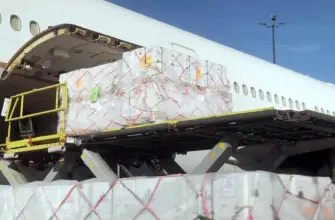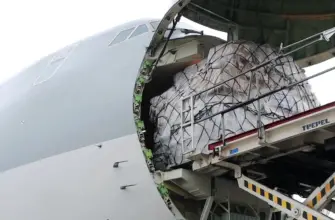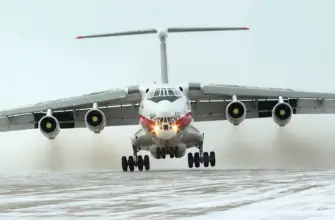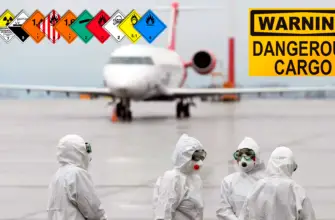- Air Transportation of Dangerous Goods
- Classes and Divisions of Dangerous Goods
- What is Required for Air Transportation of Dangerous Goods?
- Dangerous Goods Regulations for Air Transport
- Requirements for the Transportation of Dangerous Goods by Air
- Rules of Transportation. Regulatory Documents
- Requirements for Baggage Compartment
- Requirements for Loading Systems
- Documents for the Transportation of Dangerous Goods
- Geography of Flights
- Cost of Air Transportation of Dangerous Goods
Air Transportation of Dangerous Goods
Air transportation of dangerous goods poses a serious danger to the environment. Transportation of dangerous goods by air requires compliance with strict rules: special documentation, special labeling, high packaging requirements.
Dangerous goods are cargoes that pose a threat to the life and health of people and the surrounding world.
Classes and Divisions of Dangerous Goods
- easily explosive substances;
- gaseous;
- flammable liquids;
- combustible solids;
- oxidizers and organic peroxides;
- toxic and infectious products;
- radioactive;
- corrosive materials;
- other substances.
Professional employees have many years of experience in all forms of air transport – import, export, direct flights.
What is Required for Air Transportation of Dangerous Goods?
Air transport has its own specifics. When dangerous goods are transported on board an aircraft at high altitude there are changes in a number of important parameters:
- atmospheric pressure;
- vibration levels;
- the temperature of the ambient air.
This can negatively affect the chemical composition of the hazardous cargo.
Confined spaces also pose a particular threat when transporting cargo. Firstly, if something happens, the ship’s crew will have no way to get rid of the cargo. Second, neutralizing and extinguishing cargo at altitude is very difficult.
We transport dangerous goods by air with a guarantee of safety and reliability. The transportation process begins with inspection of the cargo and determination of the hazard class.
Dangerous Goods Regulations for Air Transport
For the safe transportation of dangerous goods by air, a number of important rules must be followed, which apply to:
- the cargo to be delivered;
- packaging material and marking methods;
- the luggage compartment or compartment of the aircraft;
- the loading equipment;
- package of accompanying documents;
- air transport personnel.
Aircraft personnel must know the rules of air transportation and have special training in handling dangerous goods. The rules are regulated by documents.
Transportation is carried out under the strict supervision of special employees. The shipment is sealed and arrives at the customer’s doorstep in this manner. International transport regulations are strictly observed along the way.
Requirements for the Transportation of Dangerous Goods by Air
Dangerous goods require special markings. It must conform to important requirements. Marking is applied with special paint or other method that guarantees its stability.
Special care is taken when packaging the cargo. It affects the safety of the cargo and the safety of others. Even in emergency situations, the packaging must remain airtight.
Rules of Transportation. Regulatory Documents
The rules of carriage by air were fixed in the “Convention on International Civil Aviation” in 1944 in Chicago Document number 7300. At the same time was established “International Civil Aviation Organization” – ICAO. The authoritative organization deals with the regulation of aviation relations with the law. ICAO documents are binding worldwide.
Requirements for Baggage Compartment
The luggage compartment of an aircraft or cargo compartment must have
- fasteners, to secure the cargo and prevent its vaulted movement during the flight;
- fire-fighting equipment in serviceable condition, with proper markings on the fire extinguishers;
- baggage compartment or compartment hermetically sealed from passenger cabin and cockpit.
Requirements for Loading Systems
The loading and unloading of dangerous goods is to be carried out only by competent personnel who have the necessary certification. All necessary equipment to prevent the load from falling, damaging or tipping must be available to the employees.
Pre-flight inspection services should have equipment to detect dangerous luggage if it is attempted to be transported illegally.
Specialists can provide:
- insurance and security services;
- professional loading equipment.
Documents for the Transportation of Dangerous Goods
Transportation of dangerous goods of aircraft is necessarily accompanied by the issuance of special documents, without which there will be no access not only on board the vessel, but also in the territory of the cargo terminal.
Packaging documents – you will have to fill out a lot of documents, not only for the cargo itself, but also for packaging when transporting specific cargo by air. Packaging and marking of the goods must comply with strict international standards.
Marking of cargo is placed on packaging, tanks, containers and vehicles used to deliver the cargo. See ICAO Technical Instructions for the Safe Transport of Dangerous Goods by Air for details.
Difficult problems will be solved for you:
- packing and labeling the cargo;
- delivery to the terminal;
- storage of cargo in the warehouse;
- baggage escort and security;
- and more.
Geography of Flights
The geography of AirSPS flights covers the whole world – 180 countries.
Well-developed network of agents helps to solve complex issues quickly.
Warehouse space of 140 000 m2 class “A” and “B” with adjustable temperature conditions, allows the storage of goods of any category.
Our own fleet of aircraft allows us to provide services of the highest level.
Cost of Air Transportation of Dangerous Goods
The cost of dangerous luggage transportation depends on many factors
- weight and dimensions of the cargo;
- speed of delivery;
- the complexity of the route;
- the availability of an escort and protection;
- other complications.
To calculate the exact cost please send us a request with information about the cargo and transportation.
Specialists will provide you with the cost of the commercial project. If the calculation requires additional data, you will be informed about it individually.








